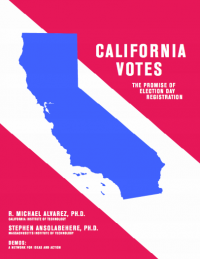ELECTION DAY REGISTRATION WILL PRODUCE HIGHER VOTER PARTICIPATION IN CALIFORNIA.
States that have adopted EDR have witnessed a 3 to 6 percentage point increase in participation among the voting-age population.
Voting among young people and those who have moved in the last six months is nearly 15 percentage points higher in states with EDR.
California might experience an even larger increase in turnout -- perhaps by as much as 9 percentage points -- because California has a younger and more mobile population.
ELECTION DAY REGISTRATION WILL INCREASE THE NUMBER OF PEOPLE ON THE REGISTRATION ROLLS IN CALIFORNIA.
In states with EDR, up to 90 percent of the electorate is registered.
Higher registration rates facilitate the distribution of voter information pamphlets and better communication about where and when to vote.
ELECTION DAY REGISTRATION WORKS IN STATES THAT CURRENTLY USE IT, AND PEOPLE LIKE IT.
Election day registration is one-step voting.
In states that use EDR, most voters register at the polls.
Election officials in states with EDR like the fact that they have more oversight over the registration process .
VOTER REGISTRATION FRAUD CAN BE MINIMIZED IN CALIFORNIA UNDER ELECTION DAY REGISTRATION.
Stricter penalties for attempted registration fraud under EDR will minimize risks.
As most voter registrations under EDR occur at the polling place and require some form of identification, voter registration will be more secure than under the current system in California.
States that currently use EDR have low rates of registration fraud because they put into place appropriate safeguards to minimize risks.
ELECTION DAY VOTER REGISTRATION SHOULD NOT SUBSTANTIALLY INCREASE THE COSTS OF ELECTIONS IN CALIFORNIA.
EDR will require new expenditures, but it may save money on other items, especially pre-election staffing. Per-capita election administration costs in major cities using EDR -- including Minneapolis and Milwaukee -- are approximately $3.50 per voting-age person.
California counties now spend between $3 and $4 per voting-age person to run elections, though some counties spend considerably more.
THE MAIN CHALLENGE WITH EDR: GETTING PEOPLE TO VOTE IN THE RIGHT PLACE.
The year after Minnesota adopted EDR, Minneapolis reported that half of all polling place registrations happened in the wrong polling place. Today less than 1 percent are reported to occur in the wrong location.
The problem can be overcome with appropriate voter education before election day, in the polling place, and after the election. These activities are routine in states that use EDR, and have little apparent fiscal impact.
